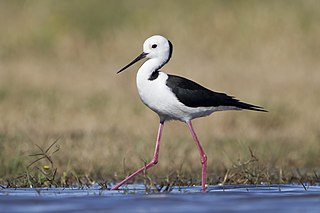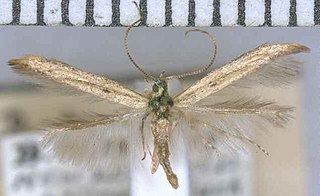
The black-fronted dotterel is a small plover wader in the family Charadriidae.

The golden pheasant, also known as the Chinese pheasant, and rainbow pheasant, is a gamebird of the order Galliformes and the family Phasianidae (pheasants). The genus name is from Ancient Greek khrusolophos, "with golden crest", and pictus is Latin for "painted" from pingere, "to paint".

Anostostomatidae is a family of insects in the order Orthoptera, widely distributed in the southern hemisphere. It is named Mimnermidae or Henicidae in some taxonomies, and common names include king crickets in Australia and South Africa, and wētā in New Zealand. Prominent members include the Parktown prawn of South Africa, and the giant wētā of New Zealand. The distribution of this family reflects a common ancestry before the fragmenting of Gondwana.

The Phasmatodea are an order of insects whose members are variously known as stick insects, stick-bugs, walkingsticks, stick animals, or bug sticks. They are also occasionally referred to as Devil's darning needles, although this name is shared by both dragonflies and crane flies. They can be generally referred to as phasmatodeans, phasmids, or ghost insects, with phasmids in the family Phylliidae called leaf insects, leaf-bugs, walking leaves, or bug leaves. The group's name is derived from the Ancient Greek φάσμα phasma, meaning an apparition or phantom, referring to their resemblance to vegetation while in fact being animals. Their natural camouflage makes them difficult for predators to detect; still, many species have one of several secondary lines of defense in the form of startle displays, spines or toxic secretions. Stick insects from the genera Phryganistria, Ctenomorpha, and Phobaeticus include the world's longest insects.

The longhorn beetles (Cerambycidae), also known as long-horned or longicorns, are a large family of beetles, with over 35,000 species described. Most species are characterized by extremely long antennae, which are often as long as or longer than the beetle's body. In various members of the family, however, the antennae are quite short and such species can be difficult to distinguish from related beetle families such as the Chrysomelidae. The scientific name of this beetle family goes back to a figure from Greek mythology: after an argument with nymphs, the shepherd Cerambus was transformed into a large beetle with horns.

The singing quail is a species of bird in the family Odontophoridae, the New World quail. It is found in Belize, El Salvador, Guatemala, Honduras, and Mexico.

The pied stilt, also known as the white-headed stilt, is a shorebird in the family Recurvirostridae. It is widely distributed with a large total population size and apparently stable population trend, occurring in Malaysia, Japan, the Philippines, Brunei, Christmas Island, Indonesia, Palau, Papua New Guinea, Australia, and New Zealand. It is listed as Least Concern on the IUCN Red List. It is sometimes considered a subspecies of the black-winged stilt.

Myrmecophagy is a feeding behavior defined by the consumption of termites or ants, particularly as pertaining to those animal species whose diets are largely or exclusively composed of said insect types. Literally, myrmecophagy means "ant-eating" rather than "termite eating". The two habits often overlap, as both of these eusocial insect types often live in large, densely populated nests requiring similar adaptations in the animal species that exploit them.

Phalaenoides glycinae, the Australian grapevine moth, is a moth of the family Noctuidae that is native to southeastern Australia. The species was first described by John Lewin in 1805.

Cryptolaemus montrouzieri, common name mealybug ladybird or mealybug destroyer, is a species of ladybird beetle native to eastern Australia. The beetle feeds on mealybugs and other scale insects, and is used to control those pests on citrus orchards worldwide.

Coccinella leonina, common name orange-spotted ladybird, is a species of ladybird native to New Zealand. It is black with orange spots. A predator species, it is present in a variety of habitats.

Batrachedra arenosella, the armoured scale eating caterpillar or the coconut moth, is a species of moth of the family Batrachedridae. It was first described by Francis Walker using specimens collected in Auckland, New Zealand. It has been hypothesised that the New Zealand moth may contain two distinct species. As well as the moth species in New Zealand, this name has been applied, perhaps incorrectly, to moths found in India, Indonesia, the Malay Peninsula, and Réunion, as well as in Australia, from the Northern Territory and northern Queensland to New South Wales and South Australia.

Echthromorpha intricatoria, also known as the cream-spotted ichneumon, is a common wasp found in Australia and New Zealand. It cannot sting and does not build nests, and is harmless to humans. The female injects eggs into pupae of moths and butterflies with the ovipositor, particularly favouring the Nymphalidae. Metacrias huttoni has been shown to be a host species for E. intricatoria.

Glaucias amyoti, commonly called the Australasian green shield bug or New Zealand vegetable bug, is a species of shield bug found in Australia, New Zealand, Timor and New Guinea.

Didymocantha obliqua is a species of longhorn beetle native to Australia. It is an established exotic in New Zealand.

The western corsair is a species of assassin bug and is one of the two species of "two spotted corsairs", the other being Rasahus biguttatus. The adults have an orange and black body and an orange spot on each wing. They feed primarily on other insects and after dark are attracted to bright lights. Unlike most of the other assassin bugs, the bite of the western corsair can be extremely painful.

Nematus oligospilus, commonly known as the willow sawfly, is a species of sawfly in the family Tenthredinidae. Native to central and northern Europe and Asia, it was first recorded in South America in the 1980s and New Zealand in 1997, and has also been introduced to Australia, South Africa and Lesotho. Its larvae feed on the leaves of various species of willow.

Monteithiella humeralis, commonly known as the pittosporum shield bug is a species of herbivorous shield bug native to Australia and introduced in New Zealand. As its common name suggests, it is most commonly observed feeding on Pittosporum plants.

Aridaeus is a genus of beetles belonging to the family Cerambycidae.




















